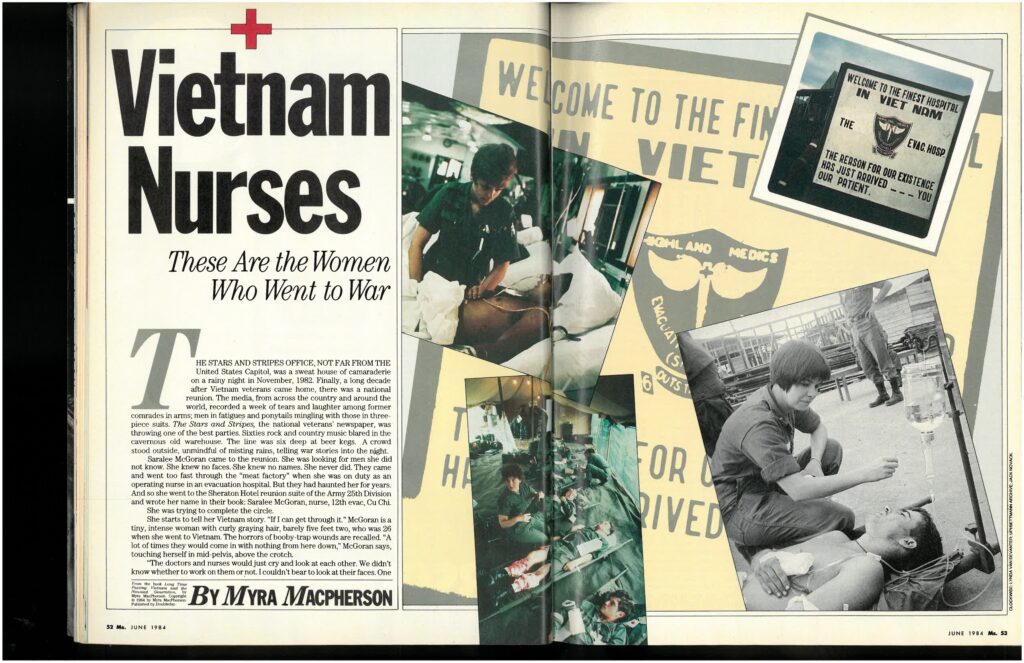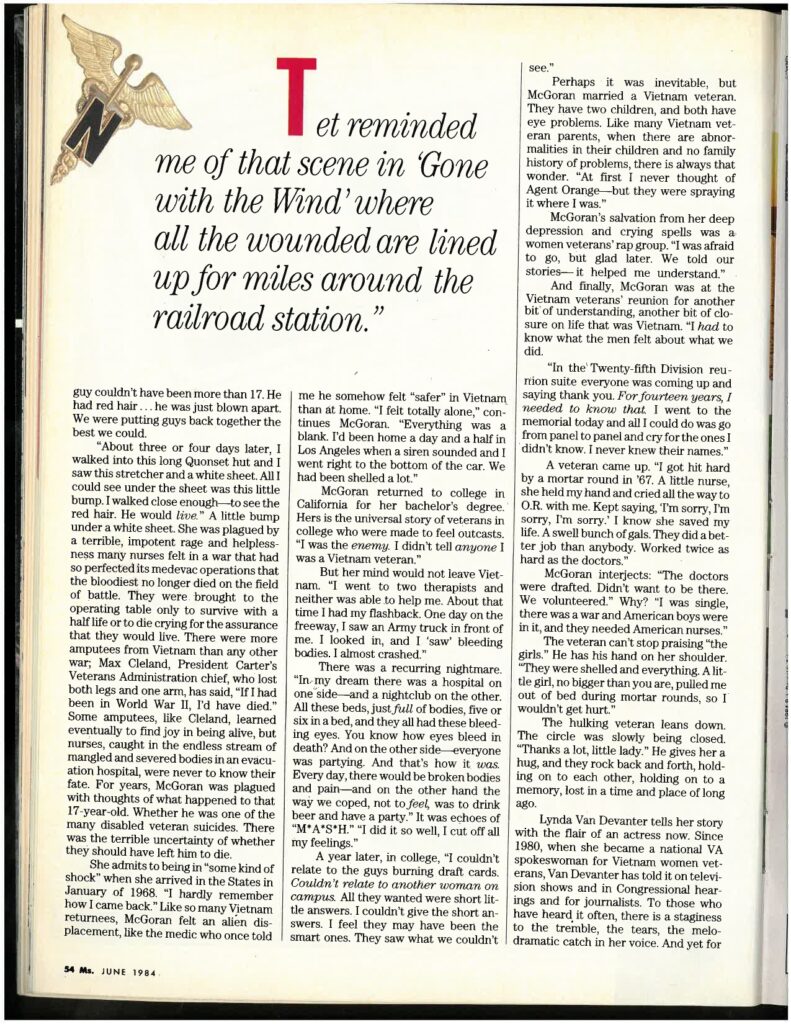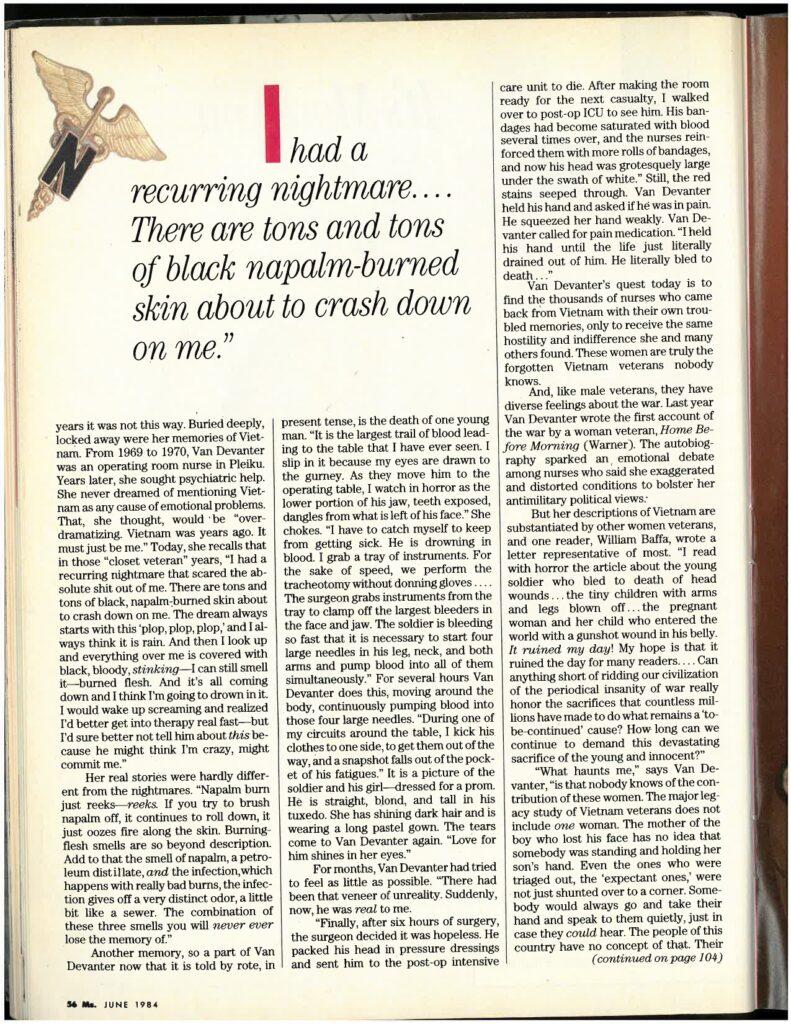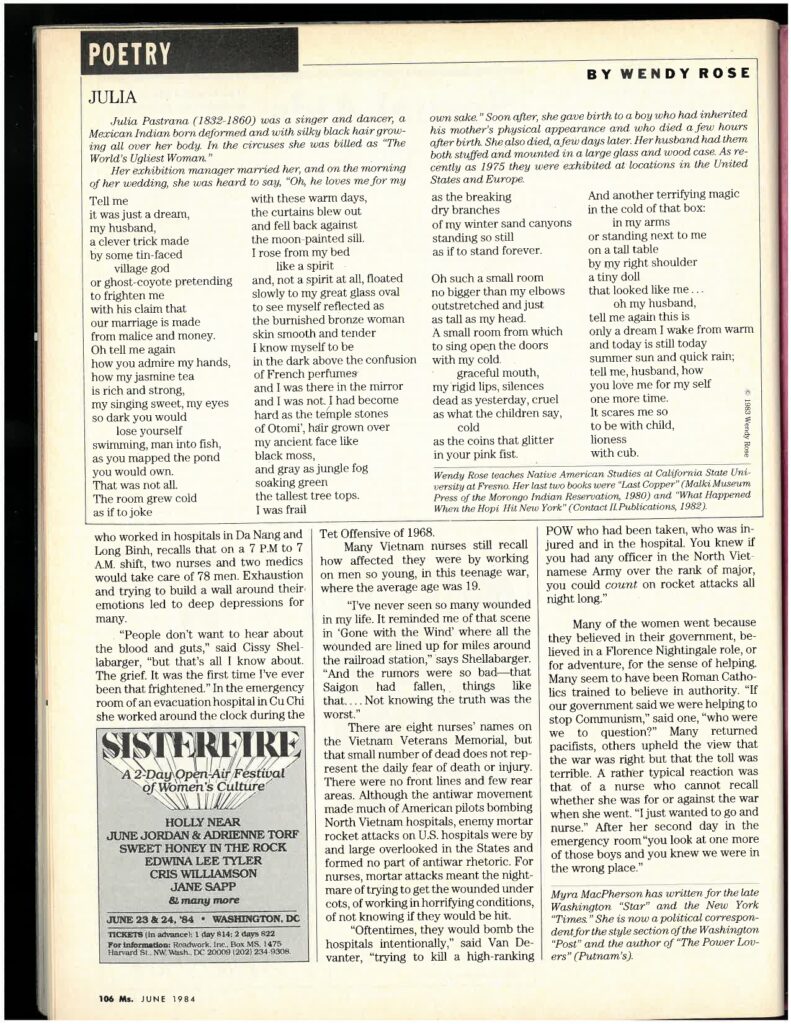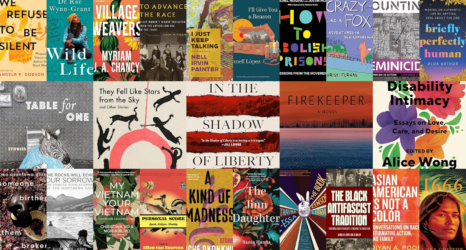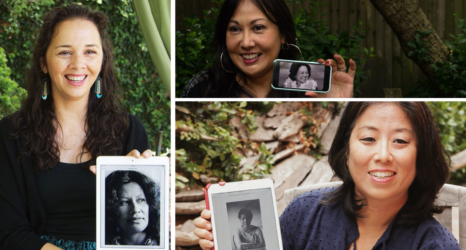“We were putting guys back together the best we could.”

To pay tribute to five decades of reporting, rebelling and truth-telling, From the Vault includes some of our favorite feminist classics from the last 50 years of Ms. For more iconic, ground-breaking stories like this, order 50 YEARS OF Ms.: THE BEST OF THE PATHFINDING MAGAZINE THAT IGNITED A REVOLUTION (Alfred A. Knopf)—a stunning collection of the most audacious, norm-breaking coverage Ms. has published.
From the June 1984 issue of Ms. magazine:
The Stars and Stripes Office, not far from the United States Capitol, was a sweat house of camaraderie on a rainy night in November 1982. Finally, a long decade after Vietnam veterans came home, there was a national reunion. The media, from across the country and around the world, recorded a week of tears and laughter among former comrades in arms; men in fatigues and ponytails mingling with those in three-piece suits. The Stars and Stripes, the national veterans’ newspaper, was throwing one of the best parties. Sixties rock and country music blared in the cavernous old warehouse. The line was six deep at beer kegs. A crowd stood outside, unmindful of misting rains, telling war stories into the night.
Saralee McGoran came to the reunion. She was looking for men she did not know. She knew no faces. She knew no names. She never did. They came and went too fast through the “meat factory” when she was on duty as an operating nurse in an evacuation hospital. But they had haunted her for years. And so she went to the Sheraton Hotel reunion suite of the Army 25th Division and wrote her name in their book: Saralee McGoran, nurse, 12th evac, Cu Chi.
She was trying to complete the circle.
She starts to tell her Vietnam story. “If I can get through it.” McGoran is a tiny, intense woman with curly graying hair, barely 5’2″, who was 26 when she went to Vietnam. The horrors of booby-trap wounds are recalled. “A lot of times they would come in with nothing from here down,” McGoran said, touching herself in mid-pelvis, above the crotch.
“The doctors and nurses would just cry and look at each other. We didn’t know whether to work on them or not. I couldn’t bear to look at their faces. One guy couldn’t have been more than 17. He had red hair. … He was just blown apart. We were putting guys back together the best we could.”
“About three or four days later, I walked into this long Quonset hut and I saw this stretcher and a white sheet. All I could see under the sheet was this little bump. I walked close enough—to see the red hair. He would live.”
A little bump under a white sheet. She was plagued by a terrible, impotent rage and helplessness many nurses felt in a war that had so perfected is medevac operations that the bloodiest no longer died on the field of battle. They were brought to the operating table only to survive with a half-life or die crying for the assurance that they would live.
There were more amputees from Vietnam than any other war; Max Cleland, President Carter’s Veterans Administration chief, who lost both legs and one arm, has said, “If I had been in World War II, I’d have died.” Some amputees, like Cleland, learned eventually to find joy in being alive, but nurses, caught in the endless stream of mangled and severed bodies in an evacuation hospital, were never to know their fate. For years, McGoran was plagued with thoughts of what happened to that 17-year-old. Whether he was one of the many disabled veteran suicides. There was the terrible uncertainty of whether they should have left him to die.
A veteran came up. “I got hit hard by a mortar round in ’67. A little nurse, she held my hand and cried all the way to the OR with me. Kept saying, ‘I’m sorry, I’m sorry, I’m sorry.’ I know she saved my life. A swell bunch of gals. They did a better job than anybody. Worked twice as hard as the doctors.”
McGoran interjected: “The doctors were drafted. Didn’t want to be there. We volunteered.” Why? “I was single, there was a war and American boys were in it, and they needed American nurses.”
The veteran can’t stop praising “the girls.” He has his hand on her shoulder. “They were shelled and everything. A little girl, no bigger than you are, pulled me out of bed during mortar rounds, so I wouldn’t get hurt.”
The hulking veteran leans down. The circle was slowly being closed. “Thanks a lot, little lady.” He gives her a hug, and they rock back and forth, holding on to each other, holding on to a memory, lost in a time and place of long ago.
So little is known about the nurses of Vietnam that there are not even accurate statistics on how many were there. Official guesstimates ranged anywhere from 7,500 to 55,000. So, it is not surprising that as vets, they often feel invisible.
Countless nurses did not know that they had been entitled to GI education benefits. Unfortunately, for most, the 10-year time period for qualification after leaving the service had expired.
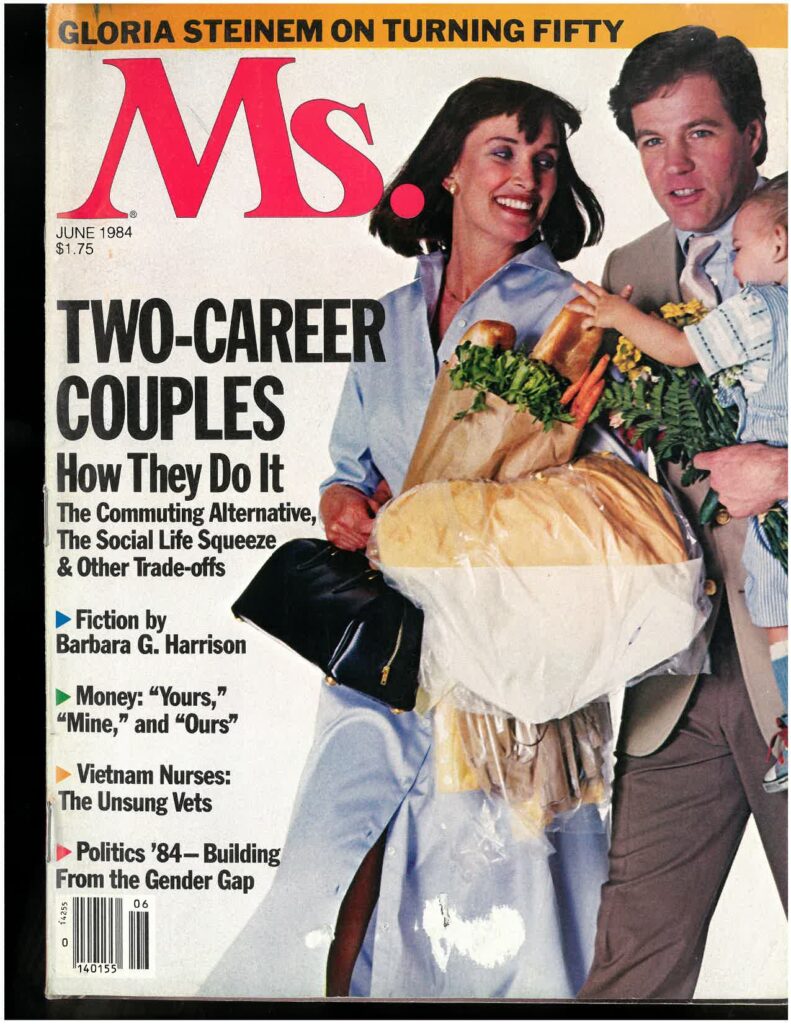
In all wars, women have been killed, maimed, disabled and injured psychologically. No Vietnam nurses argue that they have a corner on this. However, Vietnam had its special characteristics. Nurses often suffered a more severe emotional mauling than soldiers who had respites from combat. They saw waves of mutilated fresh from the battlefield, who in previous wars would never have been saved that long.
Many nurses tended to overinvest emotionally in their patients, even when their chances of living were poor. One, who worked in hospitals in Da Nang and Long Binh, recalls that on a 7 p.m. to 7 a.m. shift, two nurses and two medics would take care of 78 men. Exhaustion and trying to build a wall around their emotions led to deep depressions for many. Many Vietnam nurses still recall how affected they were by working on men so young, in this teenage war, where the average age was 19.
There are eight nurses’ names on the Vietnam Veterans Memorial, but that small number of dead does not represent the daily fear of death or injury. There were no front lines and a few rear areas.
Although the anti-war movement made much of American pilots bombing North Vietnam hospitals, enemy mortar rocket attacks on U.S. hospitals were by and large overlooked in the States and formed no part of anti-war rhetoric. For nurses, mortar attacks meant the nightmare of trying to get the wounded under cots, of working in horrifying conditions, of not knowing if they would be hit.
Editors’ note: In February 1984, then-Rep. Mary Kaptur (D-Ohio) was joined by more than 100 members of Congress in urging the Veterans Administration to include female Vietnam veterans in Centers for Disease Control epidemiological studies on the effects of Agent Orange on humans. The group also called on the VA to conduct a birth-defect study with the children of women Vietnam veterans. During her time in Congress, Kaptur was a member of the House Veterans Affairs Committee.
Up next:
U.S. democracy is at a dangerous inflection point—from the demise of abortion rights, to a lack of pay equity and parental leave, to skyrocketing maternal mortality, and attacks on trans health. Left unchecked, these crises will lead to wider gaps in political participation and representation. For 50 years, Ms. has been forging feminist journalism—reporting, rebelling and truth-telling from the front-lines, championing the Equal Rights Amendment, and centering the stories of those most impacted. With all that’s at stake for equality, we are redoubling our commitment for the next 50 years. In turn, we need your help, Support Ms. today with a donation—any amount that is meaningful to you. For as little as $5 each month, you’ll receive the print magazine along with our e-newsletters, action alerts, and invitations to Ms. Studios events and podcasts. We are grateful for your loyalty and ferocity.



